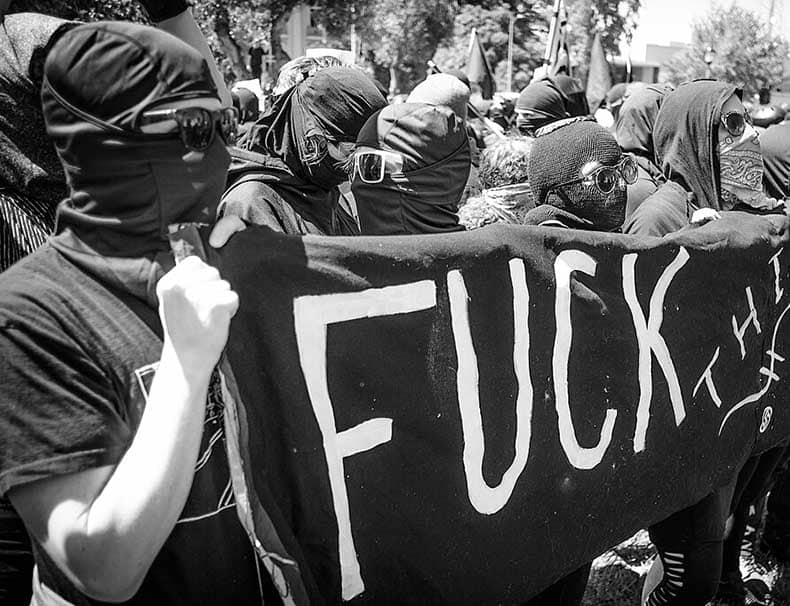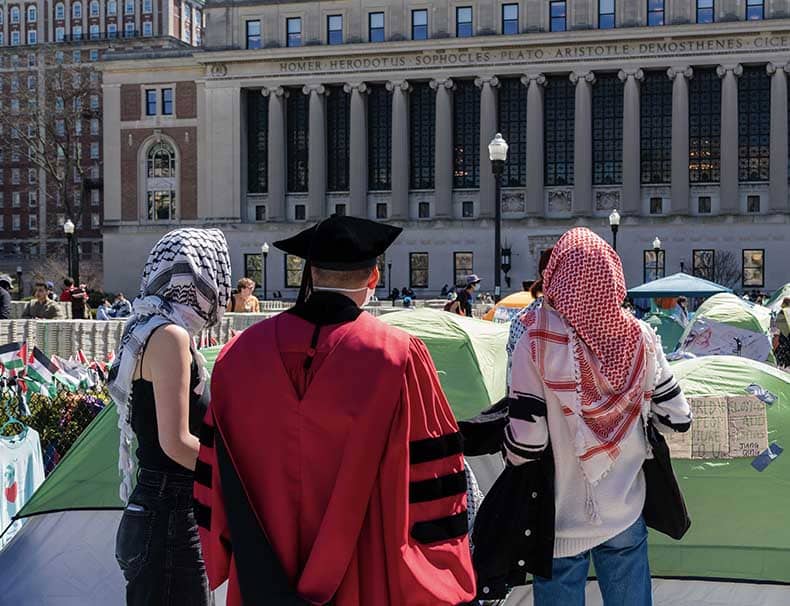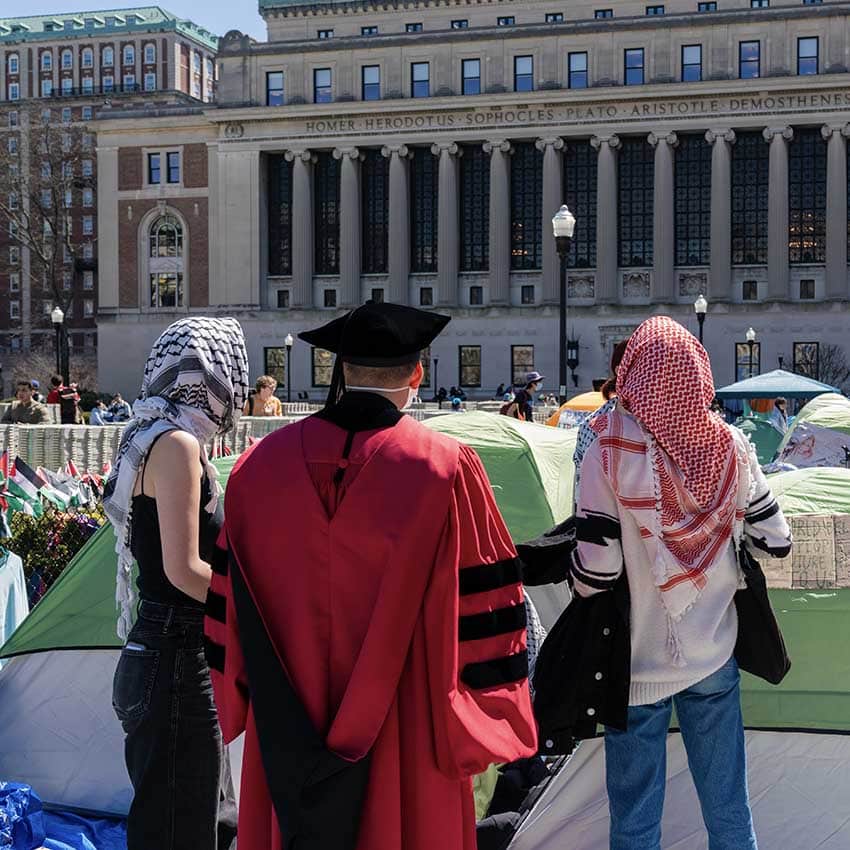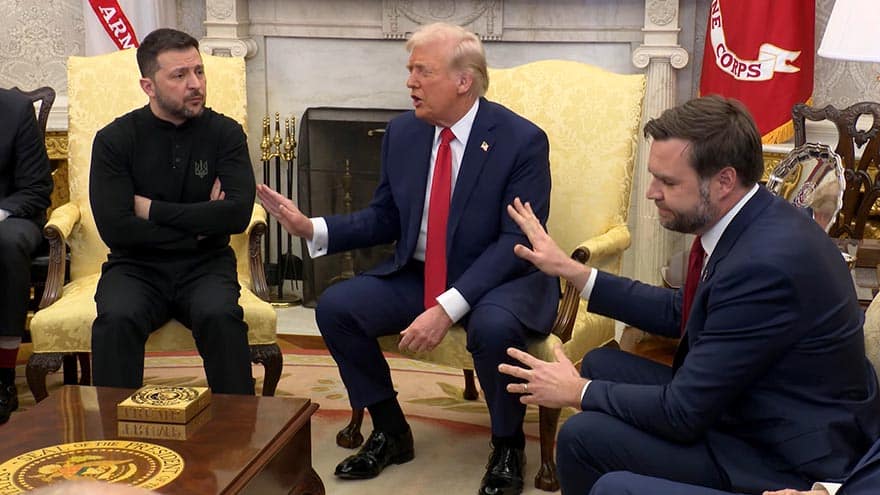In recent years, campuses of leading universities in the U.S.—from Columbia and Yale in New York to UCLA and the University of Texas in the West—have become arenas of intense protest. Demonstrators, sometimes masked, have set up tent encampments, declared “liberated zones” free from the rule of law, clashed with police, and made unequivocal demands to sever all ties with Israeli universities, while calling on the American government to impose an arms embargo on Israel. Most protests featured clear chants advocating for the destruction of the Jewish state (“From the river to the sea, Palestine will be free”). They even expressed support for the October 7 massacre, branding it as “legitimate resistance against occupation” and denying the horrific acts of murder and rape, especially against Israeli women, children, and infants. Some demonstrations included harassment of Jewish students and even acts of physical violence.
A deep investigation reveals a complex network of professional activists, wealthy donors, and organizations—some possibly connected to activity within Israel itself—raising serious questions about the actual goals behind these protests.
A Blend of Ideologies and Time-Tested Tactics
Anyone who watched videos or read reports about the campus protests could not help but notice the bizarre mixture of ideologies they represent. Protesters combine elements of radical progressive leftism, Islamism, Arab nationalism, and anarchism, with some not content merely to criticize Israel but openly praising terrorist organizations like Hamas and even states such as North Korea. The clear common denominator is fierce opposition to Israel, which they portray as committing “genocide,” and to the United States, which they view as its imperialist patron. But beyond the harsh rhetoric, what stands out is the striking similarity between these protests and previous riots, such as those associated with the Black Lives Matter movement in the summer of 2020 or the violent, far-left anarchist group Antifa.
Protesters employ tactics reminiscent of past struggles. They establish “autonomous zones” akin to those seen in Seattle and New York in recent years, where masked activists maintain order, ban outsiders from filming, and refer journalists to trained spokespersons. During clashes with police or counter-protesters, they wear coordinated outfits and masks to preserve anonymity, block arrests by locking arms or launching coordinated attacks on officers, and even use tactics like doxxing police officers to intimidate them.
At Columbia University, for instance, veteran activist Lisa Fithian, who has long been involved in radical leftist movements, was recorded instructing students on how to block Hamilton Hall, a central building on campus. At UCLA, protesters were seen undergoing combat training, indicating prior preparation.
When police cleared protesters from campuses in Texas and New York, it turned out that nearly half of those arrested—about 45 out of 79 in Texas and 134 out of 282 in New York—were not students at the universities where they demonstrated. Some were activists with long arrest records, including a 40-year-old man arrested at Columbia with a criminal history spanning two decades. This resemblance is not coincidental. These tactics require training, coordination, and experience, and they are disseminated through leftist activist networks—often via shared online documents, professional workshops, or physical gatherings. For example, the matching tents that appeared on various campuses were not purchased by some shadowy organization, as some critics claimed, but were ordered by protesters after organizers shared a specific Amazon link in a shared Google document. All of these points suggest that these protests are not the result of spontaneous student enthusiasm, but rather the product of careful planning by seasoned operatives.

Professional Activists and Radical Organizations
The protests are not driven solely by students, as one might assume. Networks of professional activists—including Antifa groups, Marxist organizations like the Party for Socialism and Liberation (PSL), and Islamist-affiliated groups such as American Muslims for Palestine (AMP) and Students for Justice in Palestine (SJP)—play a central role in organizing and escalating the demonstrations. At Columbia University, three groups in particular stood out: Students for Justice in Palestine (SJP), Jewish Voice for Peace (JVP), and Within Our Lifetime (WOL).
SJP is the campus arm of AMP, founded by Hatem Bazian, a figure with historical ties to fundraising for Hamas through organizations such as the Holy Land Foundation (HLF), which the U.S. government dismantled for supporting terrorism. Bazian, a senior lecturer at the University of California, Berkeley, called for an “intifada” in the U.S. in 2004. “Some say the Palestinians have become too radical,” he said, “but they haven’t seen what radical is yet!” He often promotes antisemitic conspiracy theories, claiming that Jews are “occupying” the U.S. Congress with their money. On his X account, he has shared blatantly antisemitic posters depicting Jews as warmongers. One such poster, labeled “Ashkenazi,” shows a smiling Hasidic Jew next to the caption: “Mom, look, I was elected. I can murder, rape, traffic organs, and steal Palestinian land. Yay!” Though Bazian was asked to apologize, the university administration did not call for his resignation.
In 2016, SJP activists burned Israeli and American flags outside the Democratic National Convention in Philadelphia, shouting “Death to Israel” and “Death to America.” Members of this group proudly claim alleged ties to Hamas. In February 2015, during a vote at the University of California on whether to adopt the BDS movement on campus, they chanted “Allahu Akbar” at Jewish students. After the vote passed in favor of the pro-Palestinian activists, one SJP member posted on Facebook, boasting, “Hamas and Sharia law have taken over UC Davis.” A follow-up comment read, “Inshallah, Israel will fall.” Just days earlier, Jewish students discovered a swastika painted on their dorm building.
Moreover, prominent activists affiliated with the organization across the U.S. have openly supported Hamas, referring to terrorist attacks by Hamas and Islamic Jihad against Israelis as inspiring forms of “resistance.” A University of Houston student posted a heroic image of terrorist Leila Khaled, writing: “Damn right I support the PFLP and the PLO in their struggle to liberate Palestine.”
At the organization’s most recent conference, there were explicit antisemitic statements and incitement to violence against Israelis and Jews: “Israel must die, and I hope it happens in my lifetime”; “F*** Zionists”; “Zionism is a disease that must be eradicated”; “White Jews must die”; “Hitler wanted a nation only of white people, Israel wants a state only of Zionists.”
In 2017, the Jerusalem Center for Public Affairs published an in-depth study on SJP, authored by Dan Diker and Jamie Berk. The study concluded that SJP is not an authentic student organization but “an antisemitic terror-affiliated network that enjoys autonomy and immunity at American colleges and universities.”
According to the report, there are “vast” connections between AMP and Palestinian terrorist organizations. For example, AMP board member Salah Sarsour laundered money and transferred it to Abd al-Awadla, a commander in Hamas’ military wing—the Izz ad-Din al-Qassam Brigades. Sarsour served eight months in an Israeli prison as a result. Rafeeq Jaber, who led the Islamic Association for Palestine (IAP)—an organization accused of funding Hamas—has been in charge of AMP’s tax filings since 2010.
A recent lawsuit claims that AMP is essentially a continuation of organizations that worked on behalf of Hamas, and that its senior officials were previously involved in similar activities. SJP operates under the fiscal sponsorship of the WESPAC Foundation, a legal structure that allows it to obscure its funding sources and operate without transparent tax reporting. This setup makes it difficult to track the funds flowing into the group, enabling it to act with relative freedom.

“Jews” Supporting Terrorism
JVP focuses on promoting the BDS movement—boycotts, divestment, and sanctions—against Israel, under the guise of a “Jewish” identity meant to attract liberal support. Over the past decade, it has received generous funding from progressive donors, including $650,000 from funds tied to George Soros, $340,000 from the Rockefeller Brothers Fund, and approximately $440,000 from the Kaphan Foundation, founded by one of Amazon’s early employees. Additionally, JVP receives funding from donor-advised funds managed by institutions such as Fidelity Investments, Charles Schwab, and Vanguard, further complicating efforts to trace its contributors. These resources enable the group to finance extensive activities, including participation in campus protests and media campaigns against Israel.
In a ranking published by the Anti-Defamation League listing the ten most hostile organizations toward Israel, JVP was included. The group claims Israel is conducting “ethnic cleansing” of Palestinians. It has even hosted convicted Palestinian terrorist Rasmea Odeh, who murdered two Israeli civilians in a 1969 Jerusalem bombing. JVP supports current-generation terrorists as well: during a recent wave of stabbings, the group signed a BDS letter praising “the mass Palestinian resistance.” Alice Rothchild, a senior figure in the group, urged her X followers to spread Hamas propaganda about the need to “protect al-Aqsa”—a slogan that has incited many Palestinians to carry out stabbing attacks on Israelis.
WOL, led by Palestinian-American activist Nerdeen Kiswani, who has a background in SJP chapters, is a group with a reputation for violence in New York. Members of the group have organized bridge and highway blockades, vandalized public buildings such as the New York Public Library, and led disruptive protests, including one at the Rockefeller Center Christmas tree lighting. WOL, which also operates under WESPAC sponsorship, has been banned from Facebook and Instagram due to explicit support for Hamas and the display of Hezbollah symbols. The group acts as the “shock troops” of the movement, with extreme rhetoric including calls to destroy Israel, such as one by senior activist Abdullah Akl, who called to “strike Tel Aviv” during a protest in New York.
These groups do not operate in a vacuum. They cooperate with broader activist networks, including Antifa groups, communist organizations like PSL, and groups like the international ANSWER Coalition, which organizes major protests in collaboration with Muslim organizations. For example, shortly before the takeover of Hamilton Hall at Columbia, a PSL-affiliated group called the People’s Forum called on activists to join the protest, spreading messages through far-left New York social media channels. These networks function in a decentralized manner, using tactics developed over decades by anarchist movements. They disseminated their ideology and strategies through professional training sessions led by figures like Pithyan, shared online documents, and even held physical meetings where activists learned how to organize demonstrations, evade arrest, and support detainees.
Wealthy Donors and Dark Money Funds
Behind the protests lies a complex funding network involving wealthy donors, foundations, and NGOs associated with the progressive left and parts of the Democratic Party. At the center of this network is the Tides Foundation, one of the largest dark money organizations in the U.S., which controls assets worth over $1 billion. Tides is supported by billionaires such as George Soros, Peter Buffett, and eBay founder Pierre Omidyar, as well as foundations like the Rockefeller Brothers Fund, Ford Foundation, and New Venture Fund, which Eric Kessler, a key figure in progressive networks, manages. Tides utilizes a structure of “fiscal sponsorships” to channel money to radical organizations while concealing the identities of donors, thereby serving as a conduit for funds without exposing their sources.
Additionally, Tides funds a wide range of organizations involved in the protests, such as the Arab Resource and Organizing Center (AROC), which, among other actions, organized illegal port blockades in San Francisco and student walkouts against Israel in cooperation with the local school district. Palestine Legal, another organization sponsored by Tides, provides legal support to protesters and files complaints with the U.S. Department of Justice, alleging “anti-Palestinian and Islamophobic” environments on campuses. The Adalah Justice Project, whose senior official was arrested during a protest in St. Louis, was involved in blocking a Boeing plant as part of an anti-Israel demonstration. The Alliance for Global Justice, which received nearly $3 million from Tides since 2020, supports Samidoun, an organization with ties to the Popular Front for the Liberation of Palestine (PFLP).
The WESPAC Foundation, which provides fiscal sponsorship to SJP and WOL, is another significant player, having received half a million dollars from the Elias Foundation since 2006, as well as donations from groups such as Grassroots International and Sparkplug, and $97,000 from Tides in 2022. WESPAC’s fiscal structure enables it to act as a conduit for funds while maintaining minimal transparency, allowing donors to support controversial goals, such as violent protests or organizations linked to terrorism, without revealing their involvement.
Experts argue that these foundations do not dictate the ideology of the protesters but control the scale of activity by regulating the flow of funds. When donors wish to escalate protests, they increase funding; when they seek to scale them back, they reduce it. For example, campus protest planning began as early as November 2023. It culminated in a national “economic blockade” on April 15, 2024, which included the blocking of bridges and roads in cities like San Francisco and New York. The links between campus protests and broader protest actions indicate high-level coordination, aiming not only to pressure Israel but also to influence U.S. domestic politics.
Political Connections and Legal Question Marks
The funding behind the protests also raises questions regarding connections to American politics. Tides, for instance, has strong ties to Barack Obama’s wing of the Democratic Party, with board members who are close to the former president’s administration, such as Cheryl Alston, appointed to a federal committee by Obama, and Dylan Orr, who became the first transgender appointee in the U.S. government. These ties raise speculation that the protests also serve as a means of internal power struggles within the party, between the rising progressive faction backed by wealthy donors and the remnants of the old Clintonian establishment.
Is all this legal? According to the U.S. Internal Revenue Code (IRS), NGOs are not permitted to fund illegal activities or encourage lawbreaking. However, law enforcement authorities have refrained from taking action against these organizations, possibly due to their political connections. For example, the Arab American Association of New York, linked to a central WOL activist, received $6.8 million in taxpayer funds since 2010. Another example is a $50 million grant from the Environmental Protection Agency (EPA) to the Climate Justice Alliance (CJA), which supported groups involved in violent protests in Georgia under the label of “environmental justice.” This grant, announced by former Vice President and recent Democratic presidential candidate Kamala Harris, raises questions about the use of public funds to support controversial activities.

Links to Far-Left Organizations in Israel
The organizations above, particularly JVP and SJP, may be directly or indirectly connected to far-left organizations in Israel that share similar goals of delegitimizing the state. The BDS movement, of which JVP is a part, is supported by Israeli groups such as “Coalition of Women for Peace” and “Who Profits,” which work to expose Israel’s economic ties with international corporations. Reports by the research institute NGO Monitor indicate that foundations like Tides and Soros have previously supported such groups through grants for ostensibly “human rights” projects. However, the connections are not always direct.
Organizations such as “Breaking the Silence” and “B’Tselem” have received funding from European and American foundations linked to the Tides network and share donors with it, pointing to a shared funding network. SJP, through AMP, maintains ties with Palestinian activists in Israel, including individuals associated with the Balad Party or the Higher Arab Monitoring Committee, who support anti-Zionist rhetoric similar to that of SJP. Reports from the Palestinian Media Watch (PMW) note that SJP activists participated in international conferences with representatives from Palestinian organizations in Israel, some of whom advocate for abolishing Israel as a Jewish state.
WOL, with its violent rhetoric, may be linked to organizations such as the Democratic Front for Peace and Equality (Hadash), whose activists sometimes participate in international events alongside groups like Samidoun. While the connections are not always direct, they are part of a global network of radical left movements aimed at undermining the legitimacy of Israel. The Israeli organization Adalah – The Legal Center for Arab Minority Rights in Israel – shares similarities with Palestine Legal, as both file legal complaints against government policies, sometimes in collaboration with international organizations. These connections, even if indirect, indicate a level of global strategic coordination aimed at pressuring Israel through legal, media, and public activism.
Trump Launches a Counteroffensive
The protests on American campuses are not a local or isolated phenomenon. They are part of a well-coordinated effort, funded by wealthy donors and driven by experienced activists with a long history of organizing demonstrations. The connections to far-left organizations in Israel strengthen the sense that this is a global campaign, aimed not only at criticizing Israeli policy but at undermining its legitimacy as a state. In the U.S., the protests may also serve internal political purposes, such as strengthening the progressive wing of the Democratic Party at the expense of traditional pro-Israel supporters. The ties to the Obama administration have sparked speculation that the protests are meant to weaken American support for Israel while promoting a policy of alignment with countries like Iran.
The big question is why law enforcement agencies have so far refrained from taking action against activities that appear to violate the law, and why public funds continue to flow to organizations supporting violent protests. The person who changed the picture is President Trump, who, since taking office for his second term, has launched a counteroffensive focused on elite universities like Harvard and Columbia, where incidents of antisemitism on campuses reportedly increased by around 300% or more in 2024. Trump deployed economic, legal, and administrative tools to impose reforms on academic institutions, aiming to protect Jewish students and ensure a safe environment.
Harvard became a central battleground in the president’s campaign. For example, the administration froze $2.2 billion in federal grants and $60 million in contracts with the university, followed by an additional freeze of $450 million, citing the university’s failure to address harassment and violence against Jewish students properly. Trump also demanded the cancellation of progressive programs, restrictions on pro-Palestinian demonstrations, the appointment of an external inspector for departments such as Middle Eastern Studies, and changes to admissions and hiring processes to ensure transparency and fairness. Additionally, the administration threatened to revoke the university’s tax-exempt status and ban the enrollment of international students, increasing financial pressure on the institution. Harvard, under President Alan Garber, took specific steps such as firing the heads of the Middle Eastern Studies center and committing to improve protection for Jewish students, but resisted demands it claimed would harm “academic independence.”
Columbia University was another significant target of the new administration’s campaign, due to intense protests on campus that included antisemitic incidents such as chants against Jewish students and the takeover of academic buildings. The administration froze $1.8 billion in federal research grants. It launched a Department of Education investigation to determine whether the university had violated laws prohibiting discrimination based on national origin or religion at institutions receiving federal funding. Trump personally demanded that Columbia suspend students and faculty involved in antisemitic demonstrations, change admissions policies to reduce the influence of “extreme ideologies,” and enhance campus security. The administration also sent federal audit teams to monitor the implementation of reforms. In response, Columbia pledged to increase enforcement against illegal protests and established a special committee to address antisemitism, despite opposing changes to its admissions policy.
Beyond Harvard and Columbia, the Trump administration expanded its campaign to other universities such as MIT and Yale through federal investigations and threats of funding cuts. The administration also promoted a nationwide policy to strengthen protections for Jewish students, including mandatory antisemitism training for faculty and support for Jewish organizations on campus. These actions were praised by conservative organizations and specific Jewish communities, who saw them as a strong commitment to Jewish security. Still, the road to eliminating antisemitism from America’s intellectual elite remains long.







